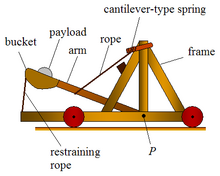Our website is made possible by displaying online advertisements to our visitors.
Please consider supporting us by disabling your ad blocker.
Catapult

A catapult is a ballistic device used to launch a projectile a great distance without the aid of gunpowder or other propellants – particularly various types of ancient and medieval siege engines.[1] A catapult uses the sudden release of stored potential energy to propel its payload. Most convert tension or torsion energy that was more slowly and manually built up within the device before release, via springs, bows, twisted rope, elastic, or any of numerous other materials and mechanisms.
During wars in the ancient times, the catapult was usually known to be the strongest heavy weaponry. In modern times the term can apply to devices ranging from a simple hand-held implement (also called a "slingshot") to a mechanism for launching aircraft from a ship.
The earliest catapults date to at least the 7th century BC, with King Uzziah of Judah recorded as equipping the walls of Jerusalem with machines that shot "great stones".[2] Catapults are mentioned in Yajurveda under the name "Jyah" in chapter 30, verse 7.[3][failed verification] In the 5th century BC the mangonel appeared in ancient China, a type of traction trebuchet and catapult.[4][5] Early uses were also attributed to Ajatashatru of Magadha in his 5th century BC war against the Licchavis.[6] Greek catapults were invented in the early 4th century BC, being attested by Diodorus Siculus as part of the equipment of a Greek army in 399 BC, and subsequently used at the siege of Motya in 397 BC.[7][8]
- ^ Gurstelle, William (2004). The art of the catapult: build Greek ballista, Roman onagers, English trebuchets, and more ancient artillery. Chicago: Chicago Review Press. ISBN 978-1-55652-526-1. OCLC 54529037.
- ^ "Bible, King James Version". quod.lib.umich.edu. Retrieved 2022-01-19.
- ^ Full text of "The Yajur Veda"
- ^ Cite error: The named reference
PaulCh1was invoked but never defined (see the help page). - ^ Chevedden et al. (1995), abstract at medievalists.net, quote: "The trebuchet, invented in China between the fifth and third centuries B.C.E., reached the Mediterranean by the sixth century C.E."
- ^ Singh, U. (2008). A History of Ancient and Early Medieval India: From the Stone Age to the 12th Century. Pearson Education. p. 272. ISBN 9788131711200. Archived from the original on July 3, 2014. Retrieved October 5, 2014.
- ^ Diod. Sic. 14.42.1.
- ^ Campbell 2003, p. 3.
Previous Page Next Page


